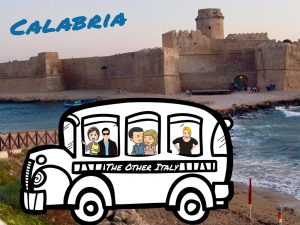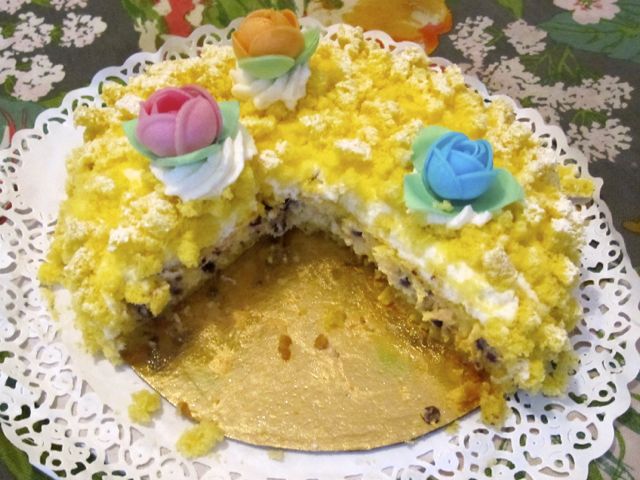“Buona festa!” (Happy Holiday!) My boss Mario greeted me with a big smile and was handing me a small bunch of yellow flowers and some foliage tied together with a ribbon. The secretary came up behind me and he picked up another little bouquet from his desk and said, “Auguri!” (Good wishes!)
“Grazie!” Of course, you say thank you when someone hands you flowers, but I’m sure I looked a bit confused. It was my first full year teaching English in Calabria, Italy. Now and then, holidays popped up that I wasn’t used to – mostly religious days. Every community had its patron saint, some well known, others less so, but those celebration days didn’t include passing out flowers on a school day. Before I could ask why I was being greeted as though it was my birthday, Mario said, “Oggi è la festa della donna!” (Today’s Woman’s Day!) He was prepared – there was another bouquet for the other female teacher and one for his wife sitting on his desk.
A DAY FOR WOMEN
It was March 8th and somehow this Giornata internazionale della donna or International Woman’s Day was a holiday that I just hadn’t been aware of. Clearly, I couldn’t have been on Facebook at that time in my life, as nothing can get past you on social media.
I was surprised when the students started filing in and wishing me well for the holiday. They looked a bit incredulously at me when I said I hadn’t heard of it. “But it started in America!” “Really?” As many of you reading this already know, those young Italians turned out to be right. The Socialist Party of America celebrated the first Woman’s Day in New York on February 28, 1909 in honor of the International Ladies’ Garment Workers’ Union strike held the previous year. They had been protesting a walkout at the Triangle Shirtwaist Factory.
TRAGEDY AND SOCIAL CHANGE
That factory would be the site of a dark moment in American industrial history just two years later. 146 garment workers, mostly immigrant women, Italian and Jewish, died in that Manhattan factory from the unsafe practice of locking building doors to prevent what management deemed as unauthorized coming and going. The devastating fire on March 25, 1911 took the lives of workers who had nowhere to escape. Flames, asphyxiation or jumping to their deaths from the ninth floor were the victims’ tragic options.
Socialist organizations in the United States and Europe demonstrated against such appalling working conditions and promoted the rights of women. Prior to the First World War, International Woman’s Days were founded in a number of European countries. In Russia and under the Soviet regime, the day was closely tied with the labor movement and thrived in that environment. In 1977 the United Nations officially marked March 8th as the day to celebrate women’s rights.
WOMAN’S DAY AND THE MIMOSA
Italy first recognized the day in 1922, and the yellow mimosa flower as its symbol appeared in 1946. Principally chosen because the tree bloomed during the period, the mimosa flowers made for a striking celebratory gesture and were also attractive economically. As I discovered, giving women a little bouquet became customary, and with today’s holiday demand for millions of branches, the price has greatly increased since the tradition began.
Women often commemorate the day with their friends. Even housewives who might not otherwise go out in the evening without their husbands will meet female friends and family members in restaurants and pizzerias. It’s a day for women!
Friendships can be celebrated any time of year, though. I found this out when visiting friends in Rieti, a town northeast of Rome in Italy’s geographic center. One day in late June, Emi announced she wanted to observe a belated Woman’s Day amongst a group of female friends since I wasn’t there in March. She said she would bring over a special cake.
WOMAN’S DAY AND MIMOSA CAKE
I would never have expected the gorgeous creation she showed up with. The cake itself was a yellow mimosa flower. And, the torta mimosa we were about to eat was made by the very creator of this Italian dessert. In fact, it received its formal launch in 1962 as the winning entry in a cake competition in San Remo. Adelmo Renzi, chef from Rieti, had designed the perfect dessert for the “City of Flowers.” Although the exact recipe has been kept a secret, pastry chefs have imitated the cake up and down the boot and it has become the culinary symbol of the Festa della donna.
The top of the cake is made with little pieces of pan di Spagna or sponge cake. Panna montata (whipped cream) and crema pasticerra (pastry cream) also play important roles in this divine dessert. Many recipes are in circulation. The cake I ate in Rieti had tiny pieces of chocolate in the mix, and it was a winning combination, indeed.
BACK TO ORIGINS
The delicate cake one would expect to find in the finest of pastry shops in the world was certainly a lovely way to celebrate womanhood. It was a far cry, however, from the first Woman’s Day in recognition of the International Ladies’ Garment Workers’ Union (ILGWU) strike and the many workplace travesties that could have been avoided and for which industry must always be vigilant.
Oddly, the “Look for the Union Label” song from the 1970s ILGWU commercials is running through my head as I write this. It was certainly catchy, and as a kid I remember being very aware of the little ILGWU labels. The song, after all, encouraged me to look for them. The label has since disappeared along with the ILGWU, which merged with another organization.
Nowadays, I search for “Made in the U.S.A.” on the label. Every once in a while, I’m successful. Luckily, “Made in Italy” can still be easily found on garments, particularly in Europe. I’ll keep searching for the label sewn in by American workers, but until then: Let them eat cake.
Cover photo of the Mimosa courtesy of Alberto Salguero, Wikipedia
Read more about Italian traditions in Calabria: The Other Italy, and Basilicata: Authentic Italy, my nonfiction books that explore culture, history, the arts, food, society and tourism of these fascinating Southern Italian regions. “Recommended to readers who appreciate all things Italian” – Library Journal. Available in paperback and e-book versions.
Thinking about a trip to Italy? Come with me! See the small-group itineraries on my Calabria tour page. “Like” Calabria: The Other Italy’s Facebook page and follow me on Karen’s Instagram and Karen’s Twitter for more beautiful pictures and information.
“Like” Calabria: The Other Italy’s Facebook page and follow me on Karen’s Instagram and Karen’s Twitter for more beautiful pictures and information.
Sign up below to receive the next blogpost directly to your email.



Comments 4
This looks like another winner. The cake looks delicious and a bit fattening—bet you have some requests for the receipe—–enjoyed Karen!!
Author
Thanks. I have no idea as to the cake’s calorie count, but I can tell you that it was as light as air! As for the recipe, it’s a secret.
Nice story K-in-C!
Author
Thanks, P-T!